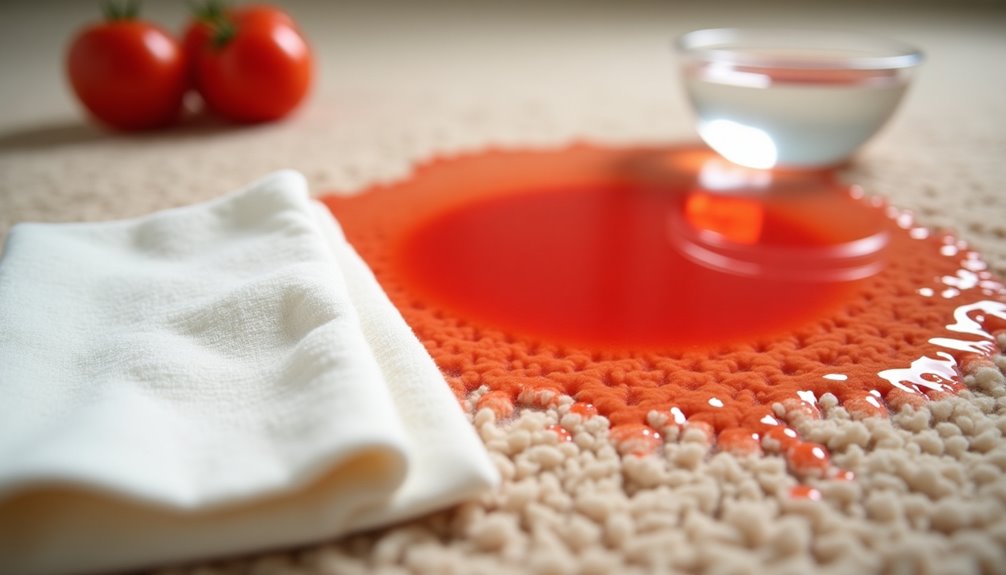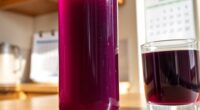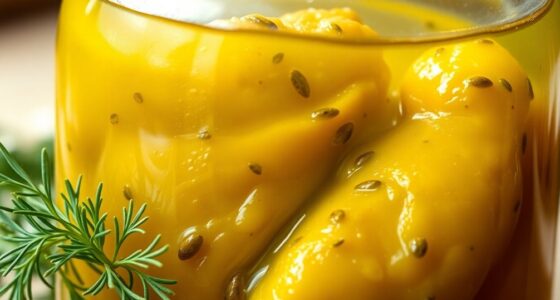To get tomato juice out of your carpet, act quickly! Blot the stain with a clean cloth to absorb excess liquid without rubbing. Mix one tablespoon of dish soap with two cups of cool water, then sponge it onto the stain. For stubborn spots, use a mixture of one tablespoon hydrogen peroxide and three tablespoons cold water, letting it soak for 30 minutes. Rinse the area with cold water and dry thoroughly. There's more effective methods to ensure your carpet looks great again.
Key Takeaways
- Blot the tomato juice stain immediately with a clean cloth to absorb excess liquid without rubbing it into the carpet fibers.
- Prepare a cleaning solution by mixing one tablespoon of dishwashing liquid with two cups of cool water and apply it to the stain.
- For stubborn stains, use a mixture of one tablespoon of hydrogen peroxide with three tablespoons of cold water, letting it soak for 30 minutes.
- Rinse the stained area with cold water to remove any cleaning solution residue, ensuring no soap remains.
- If the stain persists despite your efforts, consider hiring professional cleaners for specialized treatment and tools.

If you've spilled tomato juice on your carpet, don't panic—acting quickly can make all the difference in removing the stain. The first step you need to take is to grab a clean cloth or a paper towel and gently blot the area. This absorbs the excess liquid without rubbing, which can push the stain deeper into the fibers of your carpet. The quicker you act, the better your chances are of lifting that stubborn stain.
Once you've blotted up as much juice as possible, it's time to mix a cleaning solution. Take one tablespoon of dishwashing liquid and combine it with two cups of cool water. This mixture serves as an effective way to remove tomato sauce stains. Using a clean cloth, sponge the solution onto the stain, and continue to blot. You'll want to do this until you see the stain start to lift. Rinse out your cloth often to avoid spreading the stain further and keep the solution fresh.
If the stain proves to be a little stubborn, don't lose hope. You can try a more potent solution. Mix one tablespoon of hydrogen peroxide with three tablespoons of cold water. Apply this mixture to the stain and let it soak in for about 30 minutes. During this time, check for any color changes in your carpet to ensure the hydrogen peroxide isn't causing any damage. Patience is key here; keep an eye on it.
After you've treated the stain, it's crucial to rinse the area with cold water to remove any cleaning solution residue. You don't want to leave any soapy remnants behind, as they can attract dirt and lead to additional staining later. Use a dry towel to blot the area again, soaking up as much water as you can. Repeat this process until the area is clean and dry.
If, after all these efforts, the stain still lingers, it might be time to consider professional cleaning. Sometimes, tomato juice stains can be particularly tricky, and a professional service has the right tools and expertise to effectively remove the stain without damaging your carpet. They can assess the situation, use specialized cleaning solutions, and ensure your carpet looks as good as new.
Frequently Asked Questions
Do Tomato Juice Stains Come Out?
Yes, tomato juice stains can come out, especially if you act quickly.
When you tackle the stain right away, you're more likely to minimize its impact. Blotting the area with cold water helps lift the pigment, and using a gentle cleaning solution can further break down the stain.
If the stain persists, you might need stronger treatments or professional help, but with prompt action, you can usually restore your carpet's appearance.
Does Baking Soda Get Tomato Sauce Out of Carpet?
Yes, baking soda can definitely help get tomato sauce out of your carpet.
When you mix it with salt and water to form a paste, it effectively lifts the stain.
Apply the paste to the affected area and let it dry completely before vacuuming.
This not only removes the stain but also neutralizes any lingering odors.
Just remember to do a spot test first to avoid any discoloration on your carpet!
Will Tomato Sauce Come Out of Carpet?
Did you know that about 80% of carpet stains can be removed if treated within the first 30 minutes?
So, yes, tomato sauce can come out of your carpet! If you act quickly, you can blot the stain with a clean cloth and rinse it with cold water.
Using a mixture of dish soap and warm water helps break it down further. If it's stubborn, don't hesitate to call in a professional.
What Gets Red Juice Out of Carpet?
To get red juice out of your carpet, act fast! Blot the stain with a clean cloth to absorb as much liquid as you can.
Then, mix one tablespoon of dish soap with two cups of cool water and sponge the area while blotting.
For stubborn stains, try a solution of hydrogen peroxide and cold water. Club soda can also work; pour it on and blot.
Always test solutions on a hidden area first!
Conclusion
In conclusion, don't despair if tomato juice stains your carpet! With the right tools and techniques, you can swiftly tackle the tough mess. Remember to act promptly, blot gently, and rinse thoroughly for the best results. By following these simple steps, your carpet can regain its glorious glow. So, get ready to say goodbye to those pesky red stains and enjoy a fresh, fabulous floor once again! Keep calm and clean on!
Cindy thoroughly researches juicing trends, techniques, and recipes to provide readers with practical advice and inspiration. Her writing style is accessible, engaging, and designed to make complex concepts easy to understand. Cindy’s dedication to promoting the advantages of juicing shines through her work, empowering readers to make positive changes in their lives through the simple act of juicing.
















